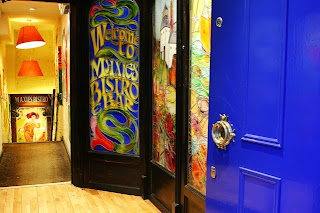Taking 3 photos (one underexposed, one correct exposure, one overexposed) of bold examples of primary colours, to see which is closest to correct - ie the colour wheel. Not the most exciting set of photos, but it is interesting to see the subtle differences which occur with slight changes in exposure when just considering the colours.
Blue Photos:
Photo 1: Underexposed

Photo 2: Correct Exposure
I think this is closest to the colour wheel colour.

Photo 3: Overexposed

Yellow Photos:
Photo 1: Underexposed

Photo 2: Correct Exposure

Photo 3: Overexposed
I think this is closest to the colour wheel colour.

Red Photos:
Photo 1: Underexposed

Photo 2: Correct Exposure
I think this is closest to the colour wheel colour.

Photo 3: Overexposed

Overexposed - generally speaking colours are lighter and can appear washed out, but sometimes colours are enhanced - brightened.
Underexposed - generally deepens and makes colours richer.



































